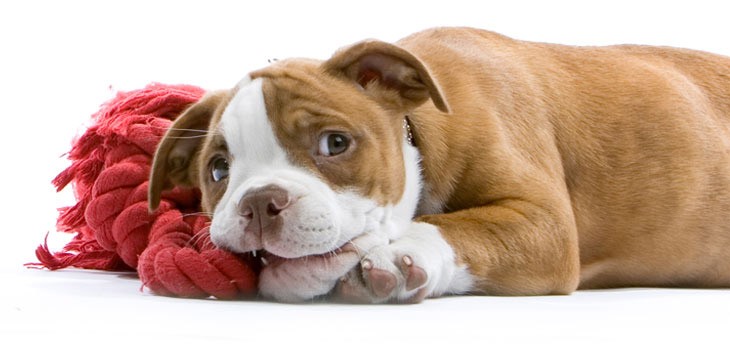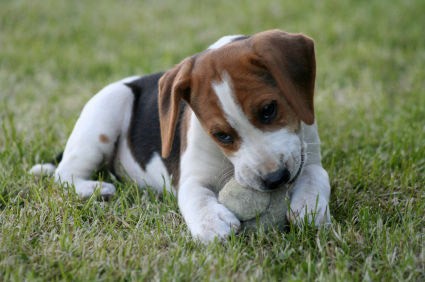Puppy Teething
Posted by Jenn on 05/12/2016
Puppies, like human babies, are born without teeth. They get their first set of 28 teeth, called deciduous or milk teeth, within the first few months. Most dogs have 42 permanent teeth by the time they are 8 months old. In between, they go through the uncomfortable process of teething, when their milk teeth fall out and their permanent teeth come in.
 Source: Not In the Dog House
Source: Not In the Dog House
When puppies are teething, they are compelled to chew things to relieve the discomfort: shoes, remote controls, etc. You can’t stop your dog from chewing—puppies need to chew—but you can direct your puppy’s chewing instinct appropriately to help keep your dog happy and your belongings safe.
Note that while puppy teething is normal, compulsive chewing can also be a sign of separation anxiety or boredom. If your adult dog gets plenty of exercise and still chews everything in sight, consult a qualified dog trainer for advice.
Dealing with Teething
-
Start by puppy-proofing your home as much as you can. Your puppy can’t destroy your stuff if she can’t get to it! A puppy in the house is an excellent incentive to tidy up. Pay attention to the items your dog seems particularly interested in chewing, and make sure they’re in a closet, on a high shelf, or behind a baby gate. If your puppy loves stealing your dirty laundry, for example, keep your laundry in a hamper that she cannot access. Consider modifying your décor for a few months. That heirloom rug may be better off in the attic until your puppy gets a little older.
Obviously, you can’t remove every piece of furniture from your house, but you can make sure your dog doesn’t have unsupervised access to it. Crate-train your puppy so that she is not roaming the halls when you cannot keep an eye on her. It’s just not realistic to give a teething puppy full rein of your home while you’re away, even if she’s completely housebroken. You can also try bitter-tasting sprays to deter your dog from chewing favorite table legs and power cords.
- Make sure she has access to a variety of chew toys with different
textures. Here are a few ideas:
- Nylon, meat-flavored chew toys
- Rope toys
- Hard rubber toys that dispense food or treats
- Cold or frozen carrots
- Chicken or beef broth frozen in ice-cube trays
- Washcloth soaked in water, then frozen
-
While many vets discourage owners from letting dogs chew tennis balls, rawhide, and chicken bones due to concerns about choking and digestion, ANY toy can pose potential dangers. Monitor all toys to make sure they’re not fraying or breaking into small pieces.
You might be tempted to give your dog discarded shoes or stuffed animals to chew on, but this can end in disaster: your dog probably won’t be able to distinguish between the old ones and the brand new versions.
Note that milk teeth are more fragile than permanent teeth, and may crack while chewing ice or other hard substances. Always bring your dog to the vet if you notice a broken tooth, since an infection could be brewing under the surface.
-
Remember that your dog doesn’t instinctively know how to behave in a human house. As with all aspects of dog training, she will get the message if you’re clear and consistent. Praise her whenever she does something you want to encourage, whether it’s using the bathroom outdoors or playing with her toys. When you catch her chewing on something inappropriate, substitute a toy and praise her for switching to it. This is especially effective as a way of reinforcing the “Drop It” command.
It can be hard, but try not to scold your puppy when you come across something she shredded. She might look guilty, but it’s just a submissive reaction to your anger—she’s already forgotten the whole episode, and has no idea why you’re yelling at her. Positive reinforcement is key!
 Source: Legacy AMC
Source: Legacy AMC
Watch for Dental Problems
Most of the time, puppies make it through teething with no problems, but sometimes dogs develop dental issues that require a vet visit. For example, a milk tooth that doesn’t fall out on its own will likely need to be removed. Depending on their position, retained deciduous teeth (or “double teeth”) can lead to infection, tooth decay, or even chewing problems. Toy breeds and breeds with short faces, such as pugs, are especially prone to teeth crowding.
